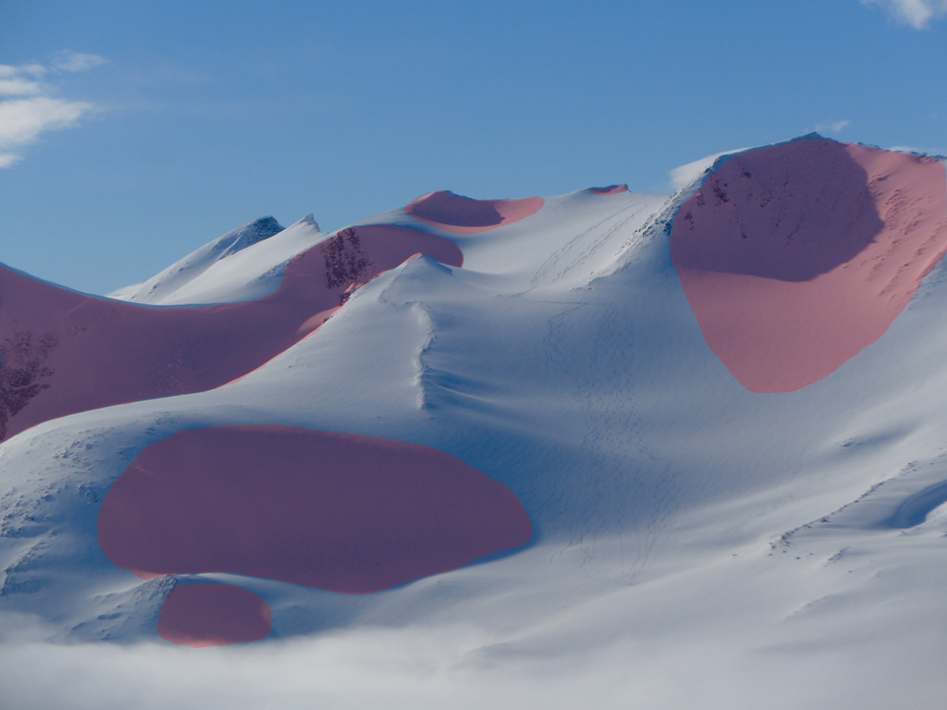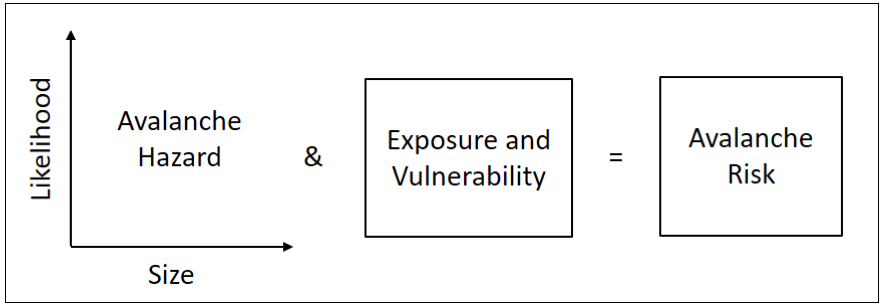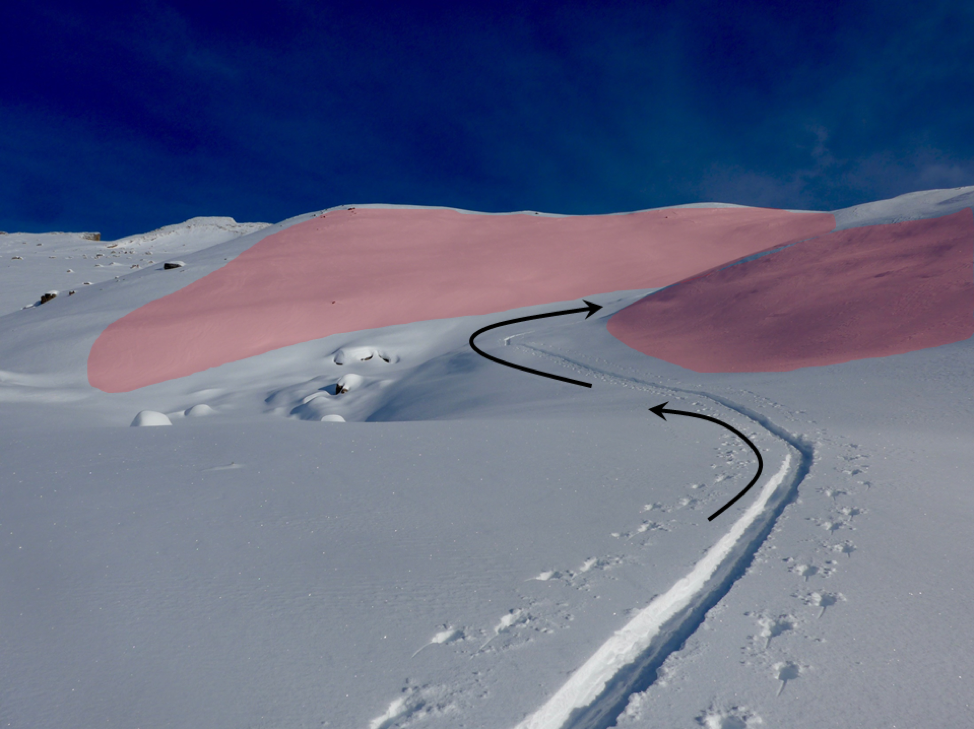Thinking in Risk
Thinking in risk means to look at your decision-making process through the lens of probability and consequence. For backcountry touring, it means travelling through and exposing yourself to avalanche hazard in a way that keeps the likelihood of being caught in an avalanche low while still realizing your objectives. Risk forces you to see the interaction between yourself and the natural environment and to visualize the possible outcomes of your decisions. As a framework for decision-making in avalanche country, thinking in risk is hard to beat for its solid connection to reality.
The beautiful thing about risk-based decision-making is its universal application across different sectors. Risk is the common denominator between decisions made in finance, medicine, engineering, and just about every other discipline you can think of, including your personal life. While the specific details and methods in each discipline are different, the overriding risk theory is the same.
Risk-based thinking works like this: 1) identify the scenario, 2) analyze the likelihood and consequence (the risk), 3) evaluate the risk by comparing it to what’s acceptable, and if it’s not acceptable, 4) mitigate it by adjusting your exposure and vulnerability until it is. Repeat.

The four step cycle of risk assessment, adapted from the international standard ISO 31000.
Avalanches present an ideal environment for risk-based thinking. The four-step cycle of risk assessment shown above should run continuously through your mind while backcountry touring, often subconsciously. It simmers quietly in the background while travelling through easy, low-risk terrain, then fires up immediately when you encounter crux situations. You’re always assessing, always adjusting, and always integrating new information into your assessment. In complex situations, your mind runs multiple scenarios per minute as you contemplate your options and prepare to make a choice. When you get good at it, much of this process happens automatically.
The key piece to thinking this way about avalanches is to separate the assessment of hazard from risk. A hazard is a source of potential harm and although closely related to risk, avalanche hazard exists without anything being at-risk. What links and differentiates hazard from risk is a key third term, exposure. To illustrate, a hazard is of no consequence to a person who is not exposed to it, thus the avalanche hazard can be high while nothing is at risk. Avalanche hazard is the likelihood of an avalanche occurring combined with its destructive potential, usually expressed as avalanche size. So the actual avalanche hazard question is: What is the chance of an avalanche occurring here and how big will it be?

This image illustrates six different avalanche-prone slopes, each with a different likelihood of avalanching and potential size. This is avalanche hazard, but there was no risk to the skiers who went down the middle because they were not exposed to the hazard.
Exposure is how you interact with the terrain in terms of your specific position and length of time exposed to the hazard. For backcountry travel decisions, exposure is the single most important consideration for controlling risk. Even during periods of high avalanche hazard, a simple reduction in exposure will reduce the risk. On small-scale terrain features, seemingly minor adjustments in how one is exposed to the hazard will change their risk—a few meters in either direction can be the difference between a low- and high-risk situation. As the classic old adage goes: terrain, terrain, terrain.

Avalanche risk is a product of avalanche hazard, exposure and vulnerability.
Vulnerability is a concept that expresses susceptibility to the impact of an avalanche and is strongly linked to consequence. The more vulnerable you are, the higher the consequences are. For example, a large tree and a person standing side by side have different vulnerabilities to the same hazard, and although their exposure in space may be the identical, the risk to each of them is different. The person may be susceptible to a Size 2 avalanche, whereas it might take a Size 4 to break the tree—thus, the person’s vulnerability is higher, as is their risk. Your position in the terrain also contributes to your vulnerability; you’re more vulnerable when you’re above a cliff than when you are not.
With all other things being equal, those who use safety equipment such as transceivers and airbags are less vulnerable than those who don’t. Same with an experienced backcountry skier who responds immediately when caught in an avalanche and escapes, as opposed to a beginner who may be slow to recognize the situation and be swept away. Every person and every group’s vulnerability is different and this has a direct bearing the level of risk they can tolerate.
Now that we’ve defined the basic ingredients of risk, lets return to that four-step risk assessment cycle and put these concepts to work.
Identify the risk
First you need to identify the risk scenario. Any combination of snowpack, terrain steep enough to slide, and people exposed to it will create an avalanche risk. During most days touring in the backcountry, your group will choose to expose themselves to some degree of avalanche risk, often many times over. This could be from either triggering the slope underfoot or getting hit by a natural avalanche from above. Either way, you must recognize the situation before you consider exposing yourself to it.
Ideally, you’ll have identified most of these situations beforehand while studying the route. You should know what avalanche paths affect your route, how you’ll interact with those paths, and what conditions will make the snowpack on each specific slope favorable or not. Knowing this ahead of time allows you to target your observations and plan your uptrack to collect the information before you reach the decision point. In other words, most of your decisions should be made before you reach the decision point.
Analyze the risk
This is the crux because of the significant amount of uncertainty associated with it. The truth is that we can never know the avalanche risk for certain, we can only estimate it. So be clear with yourself about what you know, and more importantly, what you don’t know. Plan your route to weave through different aspects of the terrain, taking advantage of good vistas and using the power of noticing to retain as much information as you can.
Backcountry avalanche risk combines avalanche hazard with the exposure and vulnerability of people. It’s useful at first to keep them separate so you can understand the hazard without being exposed to it and imagine different scenarios of exposure. This means you need to determine the likelihood and potential size of an avalanche for every slope you encounter. If you know the terrain, you can start doing this with your partners well ahead of time.
Likelihood integrates everything you know about avalanche activity, snowpack structure and snowpack tests. When a weak layer/slab combination exists, recent avalanches have been observed, and column tests produce easy, repeatable results indicating propagation, then the likelihood is high. The opposite is true when no weak layer or slab exists, no recent avalanches have been observed, and snowpack tests produce hard or no results. Look for patterns in this information and don’t rely on single point observations.
The potential size of an avalanche is a factor of the size and shape of the terrain, combined with the snowpack. It can be estimated using simple geometric principles such as: length X width X height. How long is the slope (length)? How wide might a fracture propagate (width)? How deep is the weak layer (height)? Add to this consideration for the hardness of the slab and the amount of loose snow available in the track. In reality, nobody does the math in the uptrack to determine avalanche size, but in principle these are the considerations that influence how big or small an avalanche might be. The real question might be, will it hurt you?
Having evaluated the avalanche hazard on the slope, you’re now in a position to consider your exposure to it. Or in other words, how are you going to handle the terrain? Exactly where on the terrain might you go? How many people are in your group and for how long will they be exposed? One at a time, or all together? If the slope releases, what will happen to anyone whose caught? These are questions of consequence.
Is your group up for it? In other words: what are peoples’ vulnerabilities? Any beginners or quiet introverts unwilling to speak up? Anyone feeling sick or injured or otherwise unable to handle the potential consequences? Is there anything that can be done to make someone less vulnerable?

This uptrack manages the risk by adjusting the exposure to these two slopes, weaving under and then through them while spacing out between skiers.
Evaluate the risk
This means to compare what you think the risk is—anything from a bad scare to injury to death—to what’s acceptable. The question of what’s acceptable is open-ended and can be different for everyone. Respecting lower risk tolerances than your own is important, because what’s reasonable for one person may be outrageous for the next. This is why it’s nice to have a partner who shares your values around risk, otherwise things can get tense quickly. It’s very stressful to be pressured into accepting a risk that you’re not comfortable with, and many fractures in group dynamics occur at this stage.
Mitigate or accept the risk
If you’re not comfortable with the risk, then change it by adjusting your exposure, which will change your vulnerability. Avoid the slope, change your line, space out, go one at a time, use a belay—each of these options presents a different risk scenario with a potentially different level of risk. Good risk assessment requires good communication within your group and considers all of the alternatives before landing on a decision, always factoring in uncertainty. How sure are you? But if you’ve considered everything so far, visualized the alternatives, and are prepared to accept the consequences of your decision, then its go-time.
Until the next scenario, potentially 150 meters away, when you decide where to regroup; and then again when you decide where to stop and skin up; and then again when you put the first corner into your uptrack; and once more when you decide how to ski the next slope. The cycle of risk assessment is ongoing and constant when you’re out in the mountains. You may not even realize you’re doing it, but your mind is running scenarios and evaluating options all day long.
Remember though, you can never really know the risk; you can only estimate it and give yourself margin for error. And there will be error. This is why habits are so important in all conditions, because no matter what you do, there will always be residual risk. The only time you ever actually know you were wrong is when the slope avalanches, and by then it’s too late. Until then you’ll always wonder if you’re any good, or just lucky.
Good decision-making in the mountains is a long game, meaning that you won’t know if you’re good at it until enough years have passed to give you some perspective. Your objective is to be there to enjoy that perspective. In the short-term, uncertainty is messy. It means a lot of ups and downs along the way, lots of wondering if you were wrong but never really knowing, or thinking that you were right and then getting schooled. It means lots of expecting one thing and then finding another, and plenty of times back at the road, wondering if maybe you should have kept going. The truth is, uncertainty rules and nobody ever really knows.
Thinking in risk is a mindset of probability and consequence. There’s a reason why risk is embraced worldwide by people and businesses who make decisions in environments of uncertainty. The backcountry is no different and, in fact, may just be the perfect place to ask yourself: What is the chance something will occur and, if it does, what will happen?
Grant Statham is an ACMG/IFMGA mountain guide, avalanche forecaster, and risk consultant based in Canmore, Alberta. He works with Parks Canada’s search and rescue and avalanche safety programs in Banff, Yoho, and Kootenay national parks and consults on avalanche and mountain risk projects worldwide.


